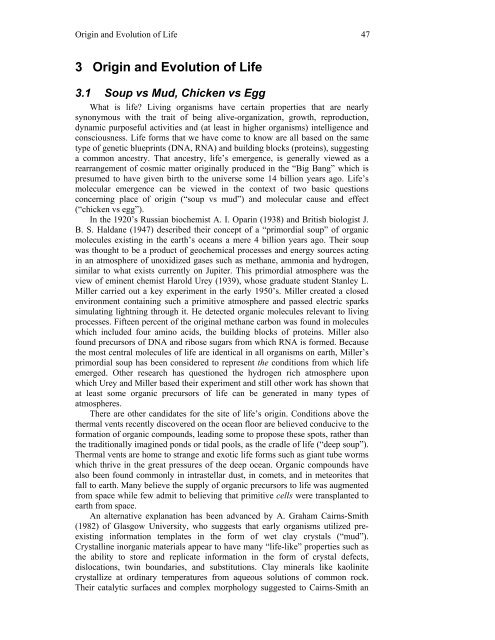ULTIMATE COMPUTING - Quantum Consciousness Studies
ULTIMATE COMPUTING - Quantum Consciousness Studies
ULTIMATE COMPUTING - Quantum Consciousness Studies
- No tags were found...
Create successful ePaper yourself
Turn your PDF publications into a flip-book with our unique Google optimized e-Paper software.
Origin and Evolution of Life 47<br />
3 Origin and Evolution of Life<br />
3.1 Soup vs Mud, Chicken vs Egg<br />
What is life Living organisms have certain properties that are nearly<br />
synonymous with the trait of being alive-organization, growth, reproduction,<br />
dynamic purposeful activities and (at least in higher organisms) intelligence and<br />
consciousness. Life forms that we have come to know are all based on the same<br />
type of genetic blueprints (DNA, RNA) and building blocks (proteins), suggesting<br />
a common ancestry. That ancestry, life’s emergence, is generally viewed as a<br />
rearrangement of cosmic matter originally produced in the “Big Bang” which is<br />
presumed to have given birth to the universe some 14 billion years ago. Life’s<br />
molecular emergence can be viewed in the context of two basic questions<br />
concerning place of origin (“soup vs mud”) and molecular cause and effect<br />
(“chicken vs egg”).<br />
In the 1920’s Russian biochemist A. I. Oparin (1938) and British biologist J.<br />
B. S. Haldane (1947) described their concept of a “primordial soup” of organic<br />
molecules existing in the earth’s oceans a mere 4 billion years ago. Their soup<br />
was thought to be a product of geochemical processes and energy sources acting<br />
in an atmosphere of unoxidized gases such as methane, ammonia and hydrogen,<br />
similar to what exists currently on Jupiter. This primordial atmosphere was the<br />
view of eminent chemist Harold Urey (1939), whose graduate student Stanley L.<br />
Miller carried out a key experiment in the early 1950’s. Miller created a closed<br />
environment containing such a primitive atmosphere and passed electric sparks<br />
simulating lightning through it. He detected organic molecules relevant to living<br />
processes. Fifteen percent of the original methane carbon was found in molecules<br />
which included four amino acids, the building blocks of proteins. Miller also<br />
found precursors of DNA and ribose sugars from which RNA is formed. Because<br />
the most central molecules of life are identical in all organisms on earth, Miller’s<br />
primordial soup has been considered to represent the conditions from which life<br />
emerged. Other research has questioned the hydrogen rich atmosphere upon<br />
which Urey and Miller based their experiment and still other work has shown that<br />
at least some organic precursors of life can be generated in many types of<br />
atmospheres.<br />
There are other candidates for the site of life’s origin. Conditions above the<br />
thermal vents recently discovered on the ocean floor are believed conducive to the<br />
formation of organic compounds, leading some to propose these spots, rather than<br />
the traditionally imagined ponds or tidal pools, as the cradle of life (“deep soup”).<br />
Thermal vents are home to strange and exotic life forms such as giant tube worms<br />
which thrive in the great pressures of the deep ocean. Organic compounds have<br />
also been found commonly in intrastellar dust, in comets, and in meteorites that<br />
fall to earth. Many believe the supply of organic precursors to life was augmented<br />
from space while few admit to believing that primitive cells were transplanted to<br />
earth from space.<br />
An alternative explanation has been advanced by A. Graham Cairns-Smith<br />
(1982) of Glasgow University, who suggests that early organisms utilized preexisting<br />
information templates in the form of wet clay crystals (“mud”).<br />
Crystalline inorganic materials appear to have many “life-like” properties such as<br />
the ability to store and replicate information in the form of crystal defects,<br />
dislocations, twin boundaries, and substitutions. Clay minerals like kaolinite<br />
crystallize at ordinary temperatures from aqueous solutions of common rock.<br />
Their catalytic surfaces and complex morphology suggested to Cairns-Smith an






